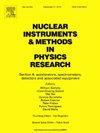T2K三维分段塑料闪烁体探测器单元立方体光学模型的表征
IF 1.4
3区 物理与天体物理
Q3 INSTRUMENTS & INSTRUMENTATION
Nuclear Instruments & Methods in Physics Research Section A-accelerators Spectrometers Detectors and Associated Equipment
Pub Date : 2025-06-26
DOI:10.1016/j.nima.2025.170757
引用次数: 0
摘要
T2K长基线中微子振荡实验的磁化近探测器(ND280)最近进行了升级,以满足测量中微子-核相互作用截面的系统不确定度的要求,这是寻找轻子电荷-奇偶对称性违反中最大的系统不确定度。升级的一个关键组件是supergd,这是一个由大约200万个光学隔离的1cm3立方体组成的3D分段塑料闪烁体探测器。supergd立方体单元显示出良好的光学性能,包括每个通道约40个光电子(p.e)的高光产率,低于3%的立方体对立方体串扰率,以及0.96 ns的亚纳秒时间分辨率。通过结合最终状态粒子的跟踪和停止功率测量,这种新型探测器能够精确地对GeV中微子相互作用进行3d成像,同时降低了系统的不确定性。基于Geant4的supergd构建块的详细光学模拟,即由三根波长移动光纤读出的塑料闪烁立方体,已经开发并使用在各种光束测试中收集的不同数据集进行了验证。本文报道了光学模型的描述以及与数据的比较。本文章由计算机程序翻译,如有差异,请以英文原文为准。
Characterization of the optical model of the T2K 3D segmented plastic scintillator detector unit cube
The magnetized near detector (ND280) of the T2K long-baseline neutrino oscillation experiment has been recently upgraded aiming to satisfy the requirement of reducing the systematic uncertainty from measuring the neutrino–nucleus interaction cross section, which is the largest systematic uncertainty in the search for leptonic charge-parity symmetry violation. A key component of the upgrade is SuperFGD, a 3D segmented plastic scintillator detector made of approximately 2,000,000 optically-isolated cubes. The SuperFGD cube unit shows promising optical performance, including a high light yield of about 40 photoelectrons (p.e.) per channel, a low cube-to-cube crosstalk rate below 3%, and a sub-nanosecond time resolution of 0.96 ns. By combining tracking and stopping power measurements of final state particles, this novel detector enables precise 3D-imaging of GeV neutrino interactions with reduced systematic uncertainties.
A detailed Geant4 based optical simulation of the SuperFGD building block, i.e. a plastic scintillating cube read out by three wavelength shifting fibers, has been developed and validated with the different datasets collected in various beam tests. In this manuscript the description of the optical model as well as the comparison with data are reported.
求助全文
通过发布文献求助,成功后即可免费获取论文全文。
去求助
来源期刊
CiteScore
3.20
自引率
21.40%
发文量
787
审稿时长
1 months
期刊介绍:
Section A of Nuclear Instruments and Methods in Physics Research publishes papers on design, manufacturing and performance of scientific instruments with an emphasis on large scale facilities. This includes the development of particle accelerators, ion sources, beam transport systems and target arrangements as well as the use of secondary phenomena such as synchrotron radiation and free electron lasers. It also includes all types of instrumentation for the detection and spectrometry of radiations from high energy processes and nuclear decays, as well as instrumentation for experiments at nuclear reactors. Specialized electronics for nuclear and other types of spectrometry as well as computerization of measurements and control systems in this area also find their place in the A section.
Theoretical as well as experimental papers are accepted.

 求助内容:
求助内容: 应助结果提醒方式:
应助结果提醒方式:


